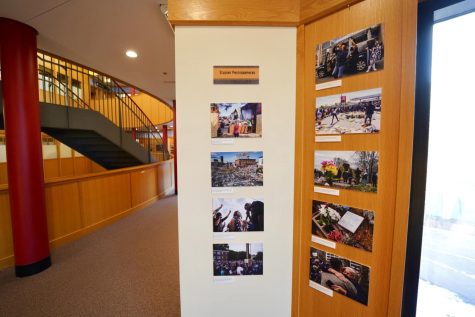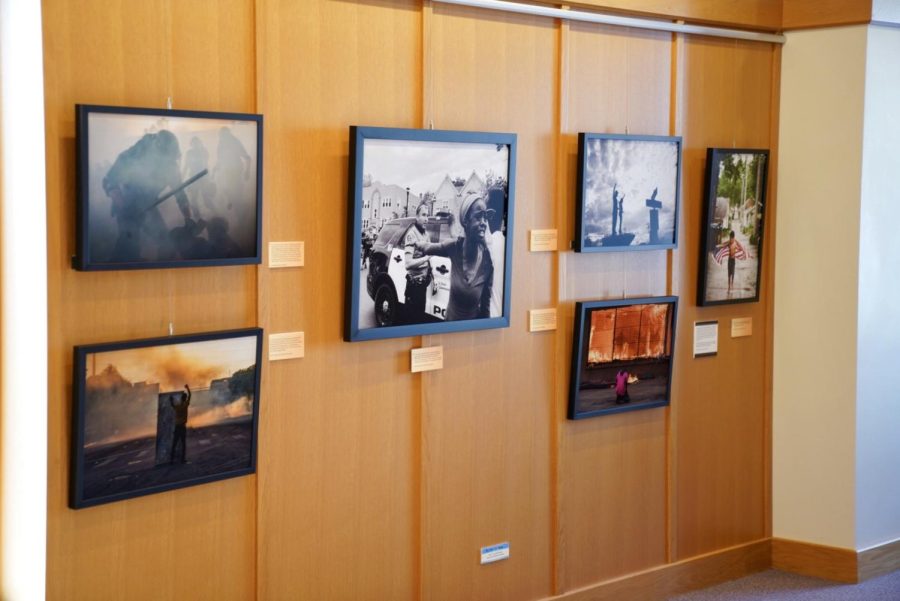The day George Floyd was murdered, Rachel Austin of Chasing Joy Photography was taking photos of her children just three blocks away from Cup Foods in her south Minneapolis neighborhood.
One of the photos shows her son, Hezekiah, age 6 at the time, holding up an American flag in their alleyway. It would soon become an iconic image representation of the calm before the global social upheaval that followed and the first image in the “Documenting A Reckoning: The Murder of George Floyd” photo gallery.
“Documenting a Reckoning,” an exhibit centered on the aftermath of George Floyd’s murder on Memorial Day of 2020, features 54 works from 37 photographers from the community, professional photojournalists and nine photos from students covering the uprising that impacted the world.
Austin wouldn’t find out about Floyd’s murder until the following morning over breakfast. That afternoon, she and her children would go to the dollar store to purchase poster board and markers to make protest signs. She continued to document the events in her neighborhood, but with the whirlwind of the following weeks, she would forget about that photo she had taken of her son for some time.
“Seeing that photo, to me, was really special because it captured my son as a kid, so much more carefree than he is today,” Austin said, reflecting on the rapid loss of her son’s innocence. “It was taken literally right before so many lives changed so drastically.”
The exhibit opened late last October at West Bank’s Elmer L. Andersen Library and will move to the Mill City Museum in early March where it will stay until June. The gallery is free to the public and open during library hours.
Shannon Brault, a third-year student in the University of Minnesota journalism program, grew up about two miles away from George Floyd Square, the name given to the intersection at 38th and Chicago where Floyd died. Her photo in the gallery depicts a sliver of the extensive memorial in the square on the day Derek Chauvin was convicted, featuring a cinder block barrier adorned with flowers and a hand-painted canvas that begins, “Great Spirit / Guide Us All to Raise / Our Voices in Solidarity / Let Our Actions Create / Real Change, Real Peace / And Justice.”
“That was really cool,” Brault said of the exhibit and her work being put on display. “Seeing that people cared, that they were there, and that this was like a celebration of the work that people have been doing to actually document what has been happening.”
Jurors for photo selection included Hubbard School of Journalism and Mass Communication professor and multimedia journalist Regina McCombs, New York Times photo editor Brent Lewis and Minneapolis-based documentary photographer Nina Robinson.
Brault said she was afraid to put her work out there initially, but was encouraged by McCombs.
“I knew that so many other big photographers in the Twin Cities were going to be in it too,” Brault said, adding that she felt honored to be included and the experience has made her realize that “the stuff I do could be good enough to get into the community journalism world.”
Billy Briggs was a concert photographer before the events of May 25, 2020. He has lived 200 feet away from the spot where George Floyd died, or “175 footsteps,” as Briggs put it, since 1997.
“I guess it just fell upon me. This is my calling and I need to document everything that goes on here. And I did,” Briggs said of his work in the neighborhood. “It doesn’t feel like a responsibility really, to me, it just feels like natural stuff to do.”
Briggs now serves as a volunteer caretaker of George Floyd Square and has documented the events within since the beginning, with the sensitivity only a neighbor could offer. He has three photos featured in the exhibit, each providing an inside look at life in the autonomous protest zone, though he has taken over 20,000 pictures since Floyd was killed.
“It was just amazing to be part of when I look back, and I didn’t think that way back when … It’s hard to put into words still,” Briggs said, adding that his goal for this year is to finally sort through all of the images he’s taken.

The exhibit itself offers a space for quiet reflection in Andersen Library’s wide, circular halls. Somber piano plays on a loop throughout, and the end of the line holds a space encouraging sticky note commentary. One vibrant pink square on the glass divider reads: “We as a collective are stronger than any unjust institution or system.” Another mentions bringing their 5-year-old daughter to reflect on the powerful snapshots of local history.
“I think many of us felt the gravity of it in a new way when we walked past the images in the exhibit and just let the feelings wash over us,” Austin said, remembering her own reaction to the gallery and those of fellow community photographers.
Editor’s Note: Regina McCombs is a member of the Daily’s Board of Directors.



















